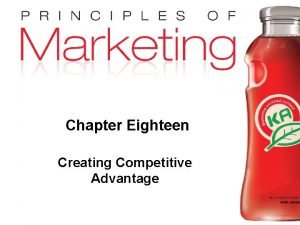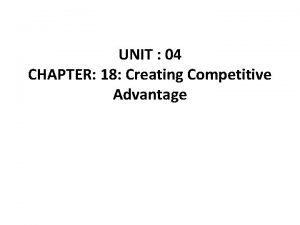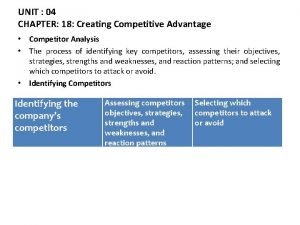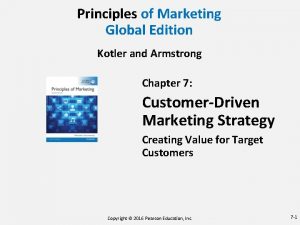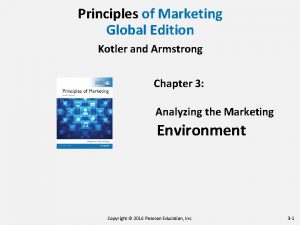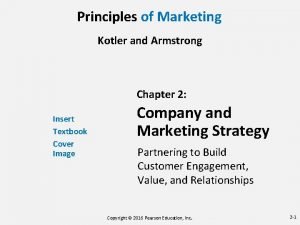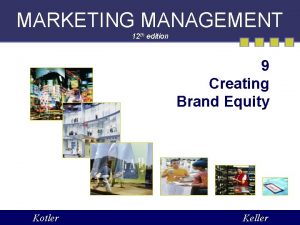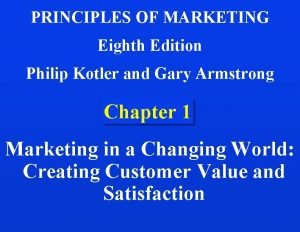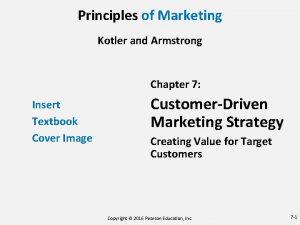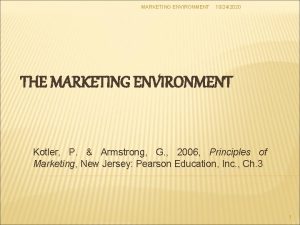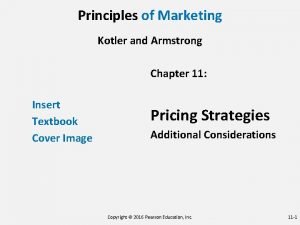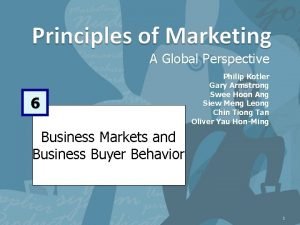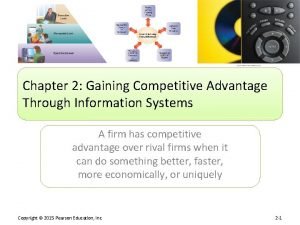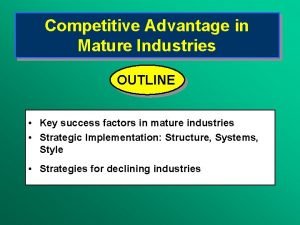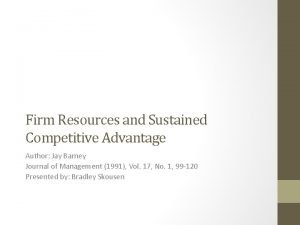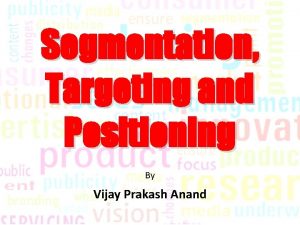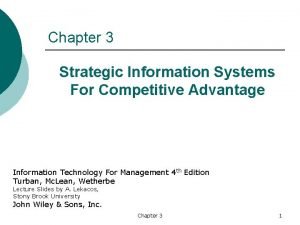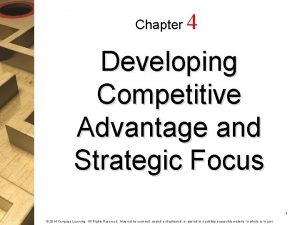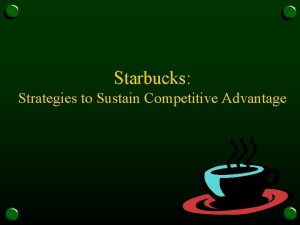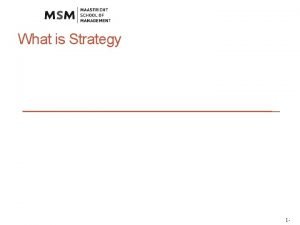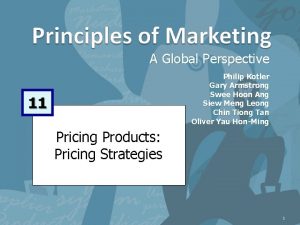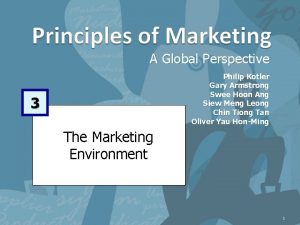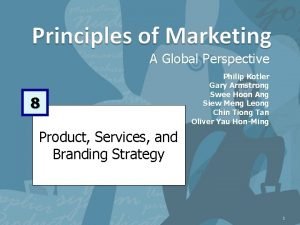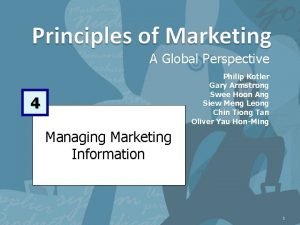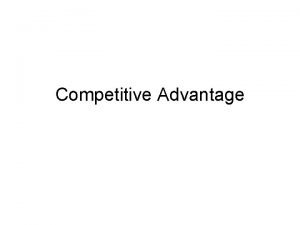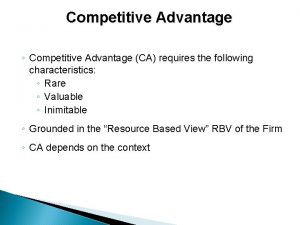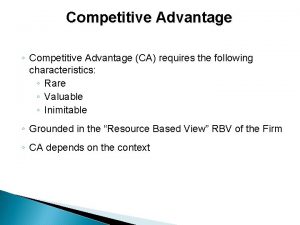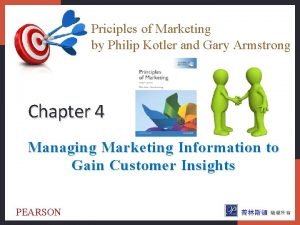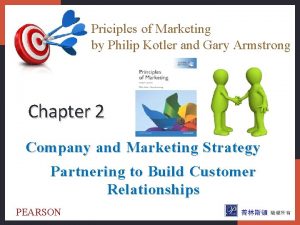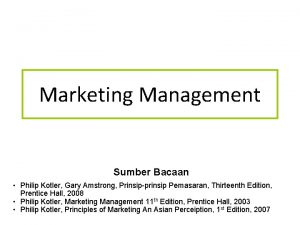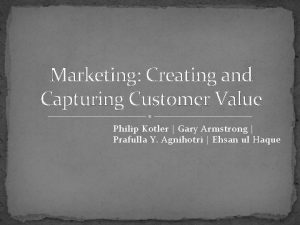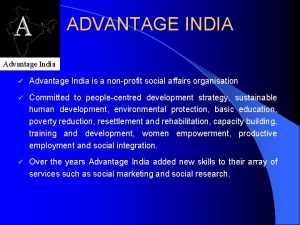Creating Competitive Advantage Philip Kotler Gary Armstrong Competitive










































- Slides: 42


Creating Competitive Advantage Philip Kotler & Gary Armstrong

Competitive Advantage An advantage over competitors gained by offering consumers greater value, either through lower prices or by providing more benefits that justify higher prices. 2

Competitor Analysis the process of identifying key competitors; assessing their objectives, strategies, strengths and weaknesses, and reaction patterns; and selecting which competitors to attack or avoid. 3

Competitor Analysis Identifying Competitors can include: 4 • All firms making the same product or class of products • All firms making products that supply the same service • All firms competing for the same consumer dollars

Competitor Analysis Identifying Competitors • 5 Competitor myopia refers to a firm focusing on what it considers to be its direct competition and not being aware of indirect or new competitors.

Competitor Analysis Identifying Competitors 6 • Industry point of view refers to competitors within the same industry. • Market point of view refers to competitors trying to satisfy the same customer need or build relationships with the same customer group.

Competitor Analysis Identifying Competitors • 7 The market point of view is considered to provide a broader set of actual and potential competitors, and a competitor map illustrates the steps buyers take in obtaining the product.

Competitor Analysis Identifying Competitors • 8 A competitor map highlights both competitive opportunities and challenges facing the firm. • Center is the list of consumer activities • First outer ring lists main competitors • Second outer ring lists indirect competitors

Competitor Analysis Assessing Competitors 9 • Competitor’s objectives • Competitor’s strategies • Competitor’s strengths and weaknesses • Competitor’s actions and reactions

Competitor Analysis Determining Competitor’s Objectives Competitor’s objectives include: 10 • Profitability • Market share growth • Cash flow • Technological leadership • Service leadership

Competitor Analysis Identifying Competitor’s Strategies • 11 A strategic group is a group of firms in an industry following the same or similar strategy in a given target market. • Competition is most intense within a strategic group • Competition among strategic groups is due to overlapping customers and lack of perceived differentiation and expansion of one strategic group into new segments

Competitor Analysis Identifying Competitor’s Strategies Companies need to understand the competitor’s ability to deliver value to its customers • 12 • Product quality • Sales force strategy • Product features • Promotion programs • Customer service • Financial strategies • Pricing policy • R&D • Distribution coverage

Competitor Analysis Assessing Competitor’s Strengths and Weaknesses • Primary data • Secondary data • Personal experience • Word of mouth • Benchmarking is the comparison of the company’s products or services to competitors or leaders in other industries to find ways to improve quality and performance. 13

Competitor Analysis Estimating Competitor’s Reactions • 14 Marketing managers need to develop an understanding of a given competitor’s mentality, culture, values, and way of doing business to anticipate how the competitor will react to the company’s marketing strategies.

Competitor Analysis Selecting Competitors to Attack and Avoid • Customer value analysis determines the benefits that target customers value and how customers rate the relative value of various competitor’s offers. • Identification of major attributes that customers value and the importance of these values • Assessment of the company’s and competitors’ performance on the valued attributes 15

Competitor Analysis Close or Distant Competitors • 16 Close competitors resemble the company the most.

Competitor Analysis Good or Bad Competitors Good competitors: • Increase total demand • Share costs of market and product development • Legitimize new technologies • Serve less attractive market segments • Provide more product differentiation • Lower the anti-trust risk • Improve bargaining power versus legislators and regulators 17

Competitor Analysis Good or Bad Competitors Bad competitors: • Try to share rather than earn in the market • Take large risks • Create disruption 18

Competitive Marketing Strategy strategies that strongly position the company against competitors and that give the company the strongest possible strategic advantage. 19

Competitive Strategy Approaches to Marketing Strategy Stages of approaches to marketing strategy include: • 20 • Entrepreneurial marketing • Formulated marketing • Intrepreneurial marketing

Competitive Strategy Approaches to Marketing Strategy • Entrepreneurial marketing involves visualizing an opportunity and constructing and implementing flexible strategies. • Formulated marketing involves developing formal marketing strategies and following them closely. • Intrepreneurial marketing involves the attempt to reestablish an internal entrepreneurial spirit and refresh marketing strategies and approaches. 21

Competitive Strategy Basic Competitive Strategies Michael Porter’s four basic competitive positioning strategies • 22 • Overall cost leadership • Differentiation • Focus • Middle-of-the-roaders

Competitive Strategy Basic Competitive Strategies • 23 Overall cost leadership strategy is when a company achieves the lowest production and distribution costs and allow it to lower its prices and gain market share.

Competitive Strategy Basic Competitive Strategies • 24 Differentiation strategy is when a company concentrates on creating a highly differentiated product line and marketing program so it comes across as an industry class leader.

Competitive Strategy Basic Competitive Strategies • 25 Focus strategy is when a company focuses its effort on serving few market segments well rather than going after the whole market.

Competitive Strategy Basic Competitive Strategies • Porter believed that companies that pursued a clear strategy would achieve superior performance and that companies without a clear strategy would not succeed. • Porter considered them to be “middle-of-the- roaders” 26

Competitive Strategy Basic Competitive Strategies Michael Treacy and Fred Wiersema suggest companies can gain leadership positions by delivering superior value to their customers in three strategies or “value disciplines. ” • 27 • Operational excellence • Customer intimacy • Product leadership

Competitive Strategy Basic Competitive Strategies • 28 Operational excellence refers to a company providing value by leading its industry in price and convenience by reducing costs and creating a lean and efficient value delivery system.

Competitive Strategy Basic Competitive Strategies • 29 Customer intimacy refers to a company providing superior value by segmenting markets and tailoring products or services to match the needs of the targeted customers.

Competitive Strategy Basic Competitive Strategies • 30 Product leadership refers to a company providing superior value by offering a continuous stream of leadingedge products or services. Product leaders are open to new ideas and solutions and bring them quickly to the market.

Competitive Strategy Competitive Positions • Market leader strategy • Market challenger strategy • Market follower strategy • Market nicher strategy 31

Competitive Strategy Competitive Positions • Market leader is the firm with the largest market share and leads the market price changes, product innovations, distribution coverage, and promotion spending. • Market challengers are firms fighting to increase market share. • Market followers are firms that want to hold onto their market share. • Market nichers are firms that serve small market segments not being pursued by other firms. 32

Competitive Strategy Market Leader Strategies • Expand total demand • Protect their current market • Expand market share 33

Competitive Strategy Market Leader Strategies Protect current market share by: • Fixing or preventing weaknesses that provide opportunities to competitors • Maintaining consistent prices that provide value • Keeping strong customer relationships • Continuous innovation 34

Competitive Strategy Market Leader Strategies Expand market share by: • Increasing market share in served markets, thus increasing profitability • Producing high-quality products • Creating good service experiences • Building close customer relationships 35

Competitive Strategy Market Challenger Strategies • Challenge the leader with an aggressive bid for more market share. • Play along with competitors and not rock the boat. • Second mover advantage occurs when a market follower observes what has made the leader successful and improves on it. • Challenges firm its own size or smaller. 36

Competitive Strategy Market Nicher Strategies • Ideal market niche is big enough to be profitable with high growth potential and has little interest from competitors. • Key to market niching is specialization 37 • Market • Customer • Product • Marketing mix

Balancing Customer and Competitor Orientations Companies need to continuously adapt strategies to changes in the competitive environment. • 38 • Competitor-centered company • Customer-centered company • Market-centered company

Balancing Customer and Competitor Orientations • Competitor-centered company spends most of its time tracking competitor’s moves and market shares and trying to find ways to counter them. • Advantage is that the company is a fighter • Disadvantage is that the company is reactive 39

Balancing Customer and Competitor Orientations • Customer-centered company spends most of its time focusing on customer developments in designing strategies. • Provides a better position than competitor-centered company to identify opportunities and build customer relationships. 40

Balancing Customer and Competitor Orientations • 41 Market-centered company spends most of its time focusing on both competitor and customer developments in designing strategies.
 Porters 3 generic strategy
Porters 3 generic strategy Chapter 18 creating competitive advantage
Chapter 18 creating competitive advantage Chapter 18 creating competitive advantage
Chapter 18 creating competitive advantage Chapter 18 creating competitive advantage
Chapter 18 creating competitive advantage Chapter 18 creating competitive advantage
Chapter 18 creating competitive advantage Customer driven marketing strategy
Customer driven marketing strategy Kotler armstrong 2016
Kotler armstrong 2016 Kotler marketing strategy
Kotler marketing strategy Creating brand equity kotler
Creating brand equity kotler Marketing management (arab world edition) philip kotler
Marketing management (arab world edition) philip kotler Marketing management (arab world edition) philip kotler
Marketing management (arab world edition) philip kotler Principles of marketing philip kotler
Principles of marketing philip kotler Principles of marketing arab world edition
Principles of marketing arab world edition Marketing management (arab world edition) philip kotler
Marketing management (arab world edition) philip kotler Marketing management (arab world edition) philip kotler
Marketing management (arab world edition) philip kotler Principles of marketing chapter 7
Principles of marketing chapter 7 Kotler’s environment model
Kotler’s environment model Armstrong chapter 11
Armstrong chapter 11 What is the value delivery process
What is the value delivery process Who is the father of marketing
Who is the father of marketing Philip kotler
Philip kotler Focused strategy
Focused strategy Comparative advantage ppf
Comparative advantage ppf Actual mechanical advantage vs ideal mechanical advantage
Actual mechanical advantage vs ideal mechanical advantage Four building blocks of competitive advantage
Four building blocks of competitive advantage Vrio jay barney
Vrio jay barney Gaining competitive advantage through information systems
Gaining competitive advantage through information systems Mature industries
Mature industries Mis competitive advantage
Mis competitive advantage Firm resources and sustained competitive advantage barney
Firm resources and sustained competitive advantage barney Human resource management gaining a competitive advantage
Human resource management gaining a competitive advantage Sustainable competitive advantage examples
Sustainable competitive advantage examples Strategic management a competitive advantage approach
Strategic management a competitive advantage approach Human resource management: gaining a competitive advantage
Human resource management: gaining a competitive advantage Psychographic segmentation
Psychographic segmentation Information system for competitive advantage in mis
Information system for competitive advantage in mis Developing competitive advantage and strategic focus
Developing competitive advantage and strategic focus Generic strategy of starbucks
Generic strategy of starbucks Human resource management: gaining a competitive advantage
Human resource management: gaining a competitive advantage Ibm mission statement
Ibm mission statement Dream box
Dream box Human resource management gaining a competitive advantage
Human resource management gaining a competitive advantage Quotes on competitive advantage
Quotes on competitive advantage

